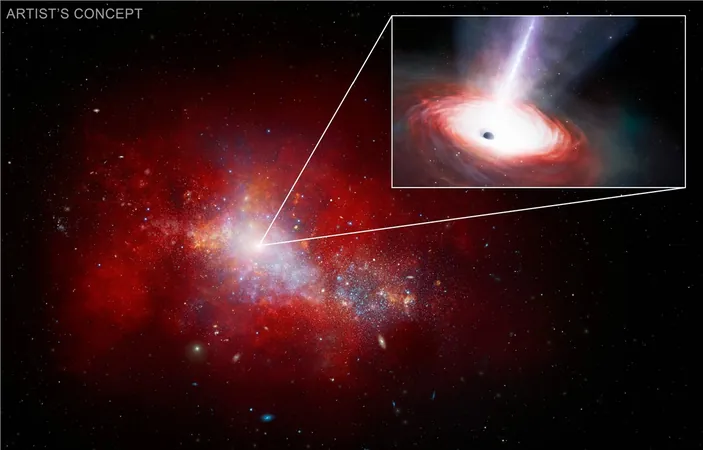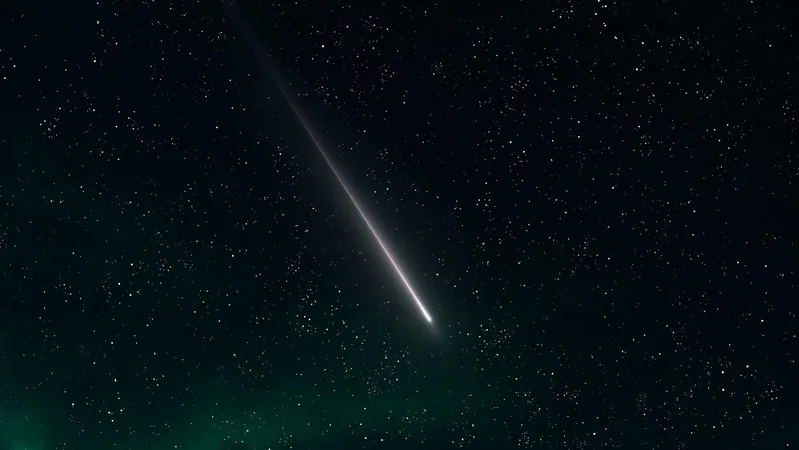
Astronomers Unveil Black Hole That Challenges Cosmic Evolution Theories!
2024-11-14
Author: William
Overview
In a breathtaking revelation, astronomers have stumbled upon a rapidly feeding black hole at the heart of a dwarf galaxy, dating back just 1.5 billion years after the Big Bang. This discovery, facilitated by NASA's cutting-edge James Webb Space Telescope and Chandra X-ray Observatory, could redefine our understanding of supermassive black hole evolution!
The Discovery of LID-568
Dubbed LID-568, this extraordinary black hole is devouring matter at an astonishing rate—over 40 times the theoretical Eddington limit, a crucial benchmark that defines the maximum rate at which a black hole can consume material while simultaneously emitting radiation. This phenomenon of extreme feeding sheds light on how supermassive black holes grew significantly within the early universe, a mystery that has puzzled astronomers for decades.
Understanding Massive Black Holes
Most galaxies are known to host supermassive black holes at their centers, but understanding how these giants reached such massive scales so quickly has remained elusive. The rapid consumption of material by LID-568 suggests that a single episode of intense accretion might account for substantial mass growth, a finding that could alter existing theories about the origins of these celestial behemoths.
Research Methodology
The team behind this discovery pieced together LID-568’s history from the COSMOS legacy survey, an extensive compilation of data gathered over 4.6 million seconds of Chandra's observations. This galaxy, primarily dazzling in X-ray light yet hidden from previous optical and near-infrared surveys, was identified through Webb’s exceptional infrared sensitivity, revealing faint emissions previously undetectable.
Significance of the Findings
Professor Hyewon Suh from the International Gemini Observatory, who led the research team, emphasizes the significance of this discovery. 'A significant portion of mass growth can occur during a single episode of rapid feeding, regardless of the black hole's origin from either light or heavy seeds,' he stated. Such seeds may originate from the collapse of primordial gas clouds or from the deaths of the universe’s first stars, concepts that have historically lacked solid observational backing—but not anymore!
Implications for Cosmic Evolution
This exciting find not only propels our understanding of black hole formation but also sparks new questions about the dynamics of cosmic growth in the universe's infancy.
Looking Forward
In a universe long believed to shroud many of its secrets, researchers are now one step closer to unraveling the mysteries of these enigmatic giants. Stay tuned for further discoveries that promise to reshape our cosmic narrative!
Further Reading
A detailed study of these findings, titled 'A super-Eddington-accreting black hole ~1.5 Gyr after the Big Bang observed with JWST,' has been published in the prestigious journal Nature Astronomy. The implications of this research may reverberate through the scientific community for years to come!









 Brasil (PT)
Brasil (PT)
 Canada (EN)
Canada (EN)
 Chile (ES)
Chile (ES)
 España (ES)
España (ES)
 France (FR)
France (FR)
 Hong Kong (EN)
Hong Kong (EN)
 Italia (IT)
Italia (IT)
 日本 (JA)
日本 (JA)
 Magyarország (HU)
Magyarország (HU)
 Norge (NO)
Norge (NO)
 Polska (PL)
Polska (PL)
 Schweiz (DE)
Schweiz (DE)
 Singapore (EN)
Singapore (EN)
 Sverige (SV)
Sverige (SV)
 Suomi (FI)
Suomi (FI)
 Türkiye (TR)
Türkiye (TR)